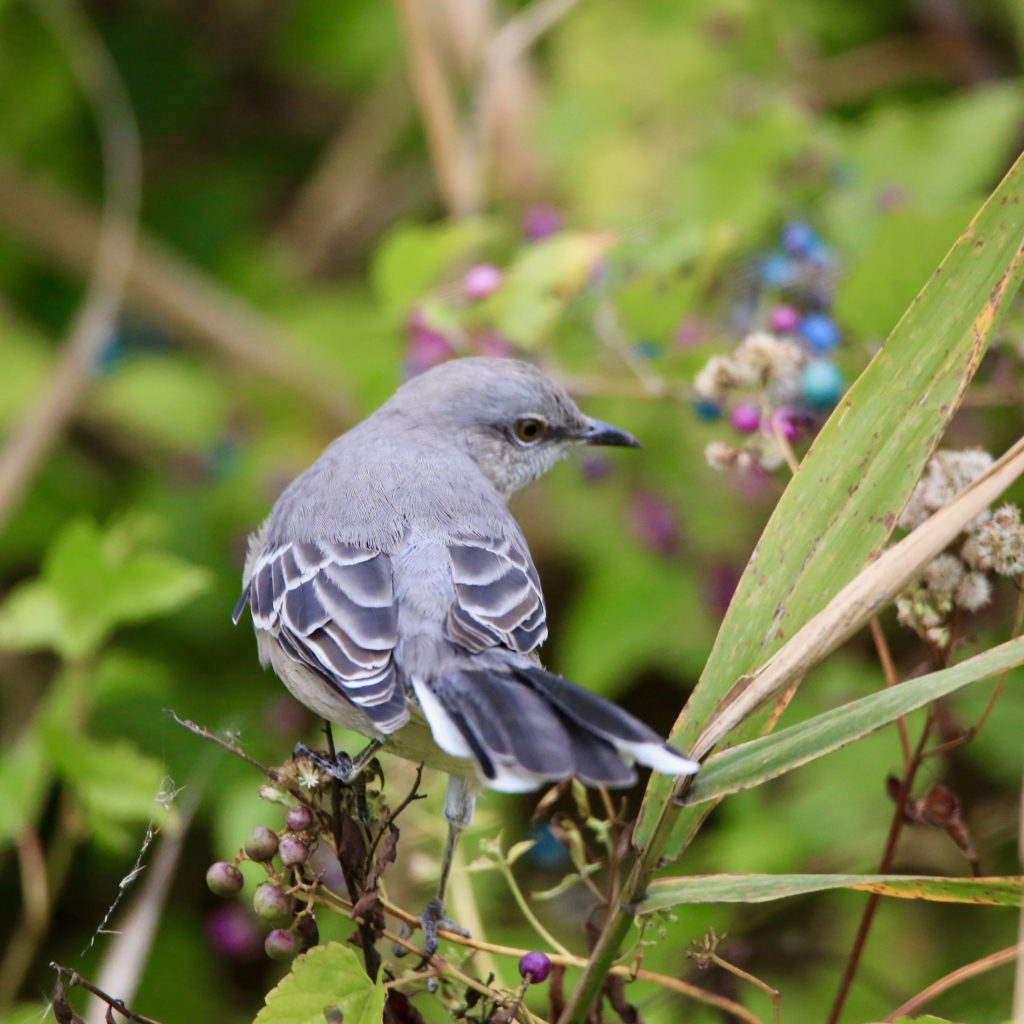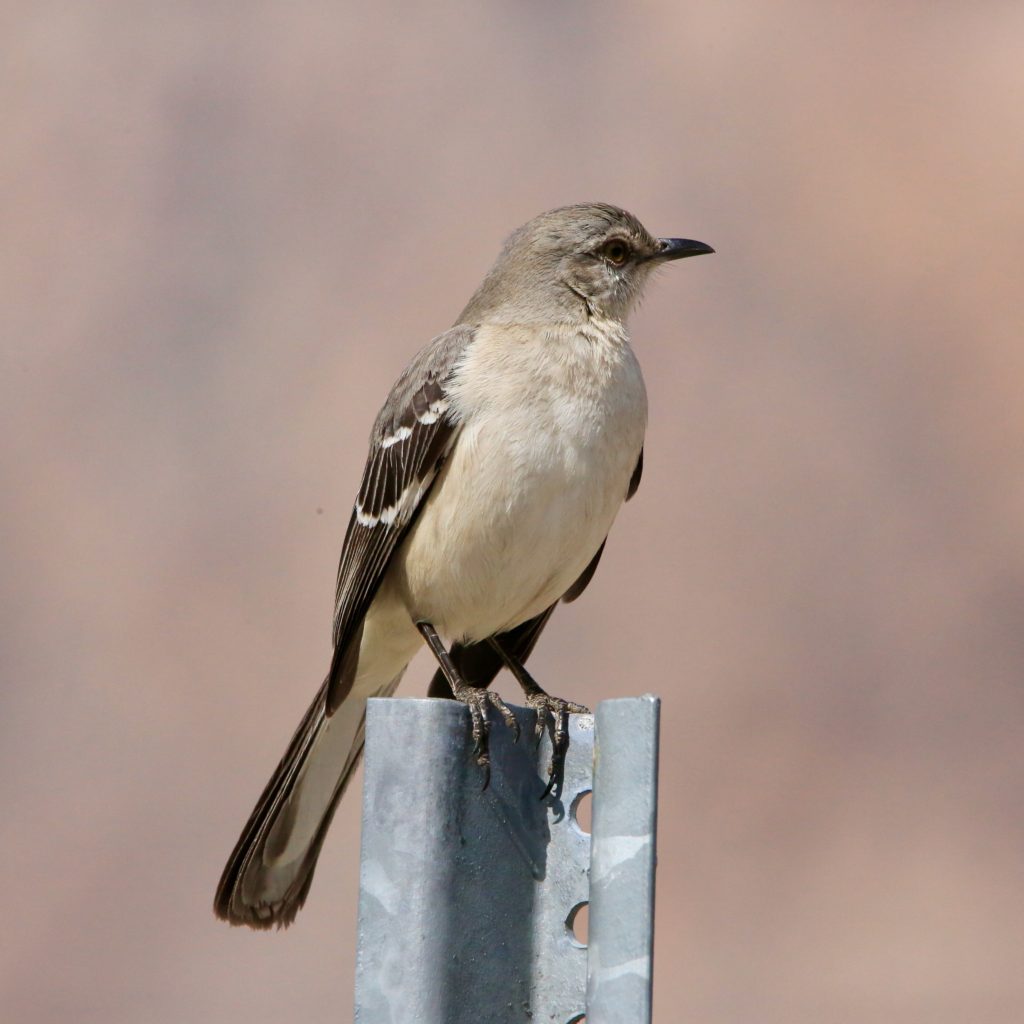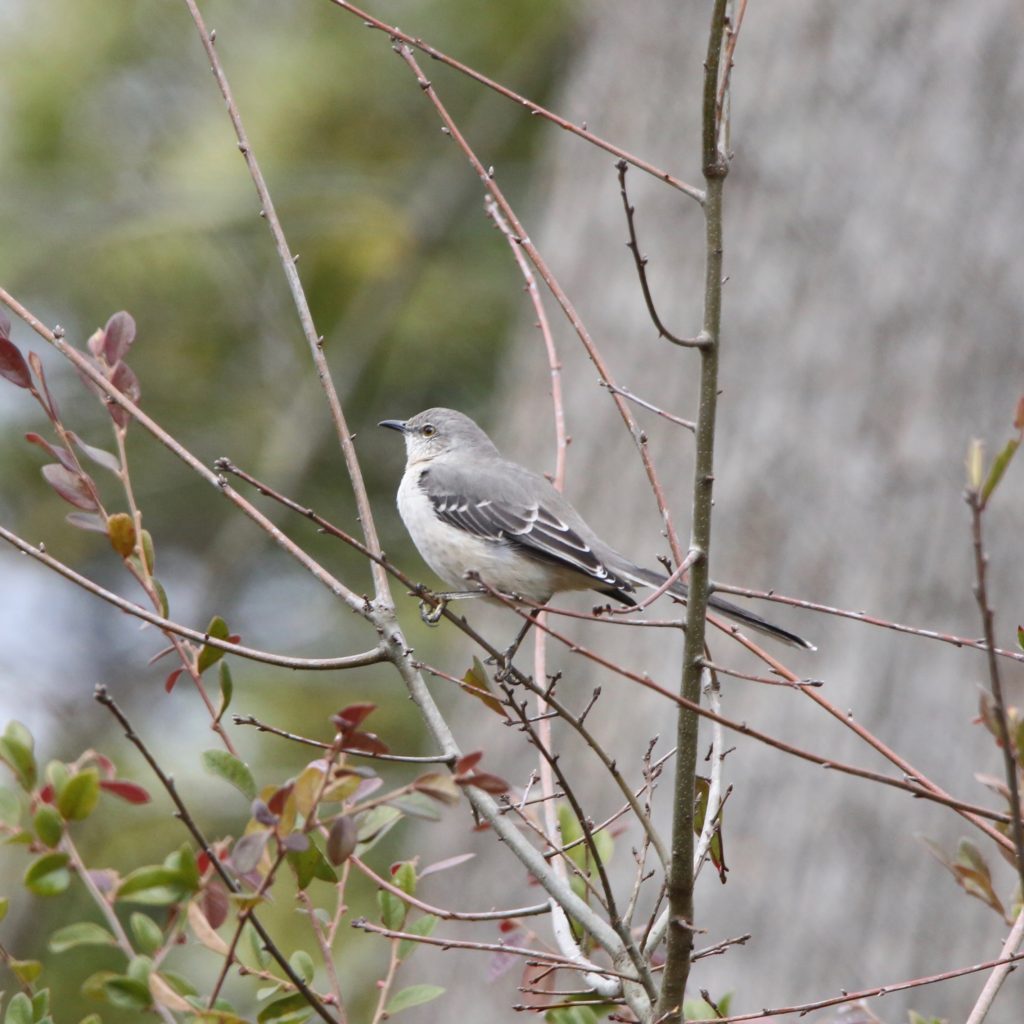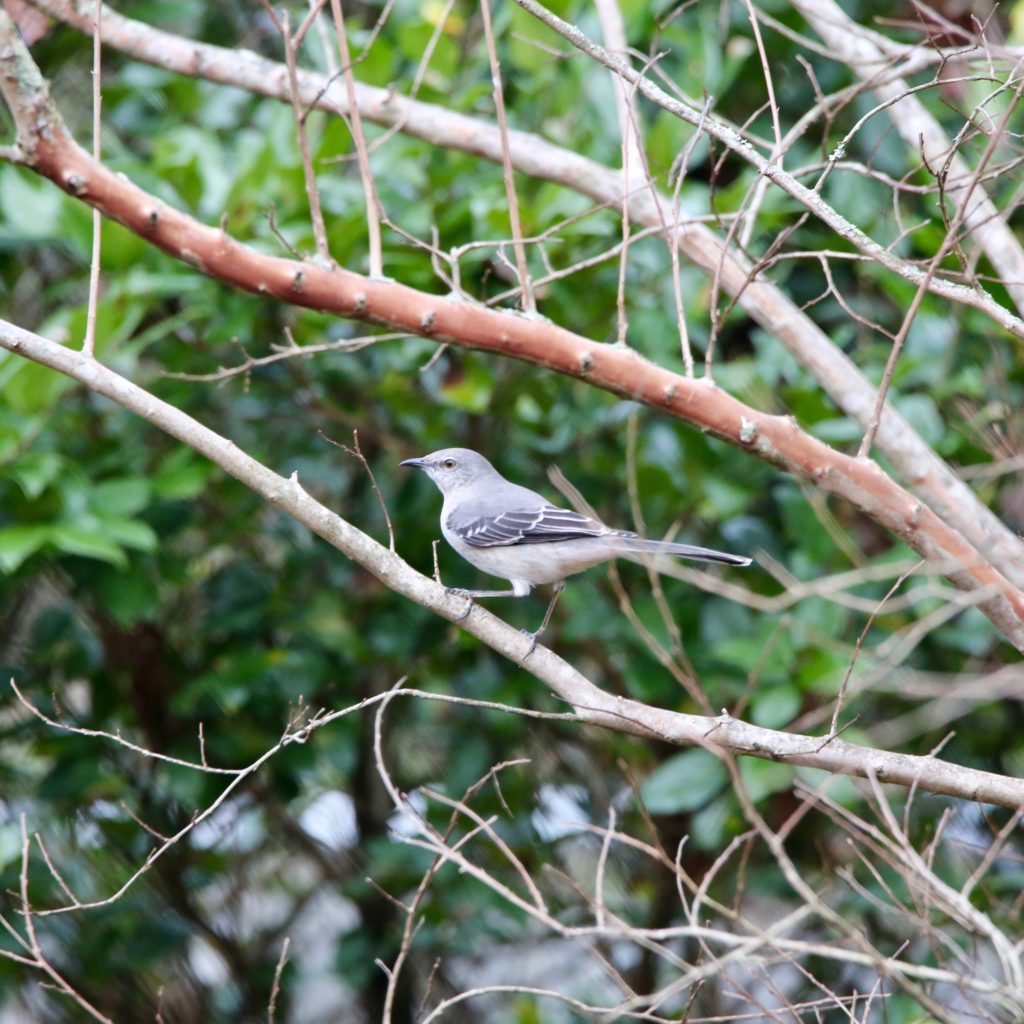
The Northern Mockingbird
A Northern Mockingbird is a fun bird to see while bird watching. Below are some tips to help you identify Northern Mockingbirds. We have also put together a list of fun Northern Mockingbird t-shirts, Northern Mockingbird bird patches, birdhouses, bird feeders, binoculars, stickers, and other fun bird-watching items.
About Northern Mockingbirds
It is a permanent resident of North America moving south only during harsh weather. It is well known for its ability to mimic sounds and endless singing. Being territorial, they fly around intruders flashing their white wing patterns to scare them off. 14 years, 10 months is the oldest Northern Mockingbird to be branded. Northern Mockingbirds are known for having a high intellect supported by their ability to be able to recognize individuals and being able to recognize threats and friendlies.
Description and Identification
Northern Mockingbirds are medium-sized, slender songbirds that are about 8 – 10 inches in
length. They have small heads, long legs, and long and thin bills that have a slight downward
curve. Their short, rounded, and broad wings have a wingspan of 12.2 – 13.8 inches; their
wings highlight their tails and make them seem longer when in flight. Both sexes look alike,
but the males are slightly larger than the females. They are gray-brown overall with pale
breasts and bellies, and two white bars on each wing. A white patch in each wing is also
visible on perched birds, and in-flight these become large white flashes.
Northern Mockingbird Color Pattern
The Northern Mockingbird is mostly gray with some shades of brown and a pale breast. They have white patches visible as they perch on tree branches and during flight these white patches flash.
Northern Mockingbird Size
Northern Mockingbirds are medium-sized songbirds with slim bodies and long tails. Their slim body is adorned with a small head and thin bill, and long legs. The relative size of an adult Northern Mockingbird is:
- Length 21 – 26 cm
- Weight 45 – 58 g
- Wingspan 31 – 35 cm
Northern Mockingbird Behavior
Throughout the year, they can be found in pairs or alone protecting their territory aggressively from intruders. They sing through most of February to August with the females joining in the singing but her voice is usually lower than that of the male. Northern mockingbirds fly around flashing their white patches but it is not clear why researchers assume it is to stun insects making them easier to catch.
Northern Mockingbird Food
Northern Mockingbirds are omnivores that primarily feed on insects and fruits. Their insect
diet usually consists of common prey like beetles, earthworms, moths, butterflies, ants, bees,
wasps, and grasshoppers. They may sometimes consume small lizards as well. However,
most of their animal prey is limited to the summer seasons when insect populations are
abundant. During the winters, they eat a variety of fruits like apples, tomatoes, and berries.
The fruit of multiflora rose in particular is a favorite of these birds.
They are omnivores with their main food being insects but switch to fruits over the fall and winter. Their prey includes bees, ants, grasshoppers, and small lizards. Northern Mockingbirds drink sap from cut trees. They sometimes forage the ground for seeds among the vegetation and small insects.
Northern Mockingbird Habitat
These birds can be found in areas with open ground and with shrubby vegetation like
hedges, fruiting bushes, and thickets. When they forage on the ground, they gravitate
towards grassy areas rather than bare spots. In the eastern regions, they can be sound in
suburban and urban areas like parks, gardens, and cultivated lands. They also seem to
prefer mowed lawns with shrubs that are close to areas with sufficient shade for nesting. In
the western regions, they are found along with desert scrub and chaparral. They do not inhabit
densely forested areas and are found around their breeding habitats all year long.
Northern Mockingbirds are found in open areas with hedges with fruits. As they forage they prefer grasslands. They are common in parks, agricultural areas, and suburban areas. It is generally a permanent resident in its territory rarely moving.
Range and Migration

Northern Mockingbirds are the only mockingbirds found in North America, seemingly always
singing a tune. They are best known for being able to mimic the songs of other birds, as well
as the sounds of insects and amphibians. They are non-migratory and are permanent
residents of their habitats across central and southern United States, Mexico, and the
The Caribbean. Their breeding range is from the Maritime provinces of Canada, most of
The Continental United States, the Greater Antilles, and the majority of Mexico till eastern
Oaxaca and Veracruz. Although they are year-round residents, birds that live in the northern
portion of the range have been observed to move south during winters. Vagrants have also
been frequently spotted in south-eastern Alaska and at least three times in Britain.
Northern Mockingbird Lifecycle
Male mockingbirds choose the nest site and build it even before courting the female. A female lays 2 to 6 eggs incubating them for a period of 13 to 13 days. The chick’s nest for an average of 13 days before leaving the nest.
Northern Mockingbird Nesting
These birds can be found nesting in shrubs and trees, usually 3 – 10 feet off the ground but
sometimes as high as 60 feet. The site is presumably chosen by the males as they begin
building several ones before the final selection is made by the females. In many cases,
females begin laying eggs in another nest while the males are still caring for fledglings in the
previous ones. The nests themselves are made of dead twigs shaped into an open cup. The
interiors are then lined with grasses, rootlets, leaves, and sometimes bits of plastic,
aluminum foil, shredded cigarette filters, and other bits of trash. While the foundation is
constructed by the males, the females are responsible for providing the inner lining.
Ornithology
Bird Watching Academy & Camp Subscription Boxes
At Bird Watching Academy & Camp we help kids, youth, and adults get excited and involved in bird watching. We have several monthly subscription boxes that you can subscribe to. Our monthly subscription boxes help kids, youth, and adults learn about birds, bird watching, and bird conservation.
Bird Watching Binoculars for Identifying Northern Mockingbirds
The most common types of bird-watching binoculars for viewing Northern Mockingbirds are 8×21 binoculars and 10×42 binoculars. Bird Watching Academy & Camp sells really nice 8×21 binoculars and 10×42 binoculars. You can view and purchase them here.
Northern Mockingbird T-shirts
If you love the Northern Mockingbird you should purchase a Bird Watching Academy & Camp T-shirt. To help support bird conservation we donate 10 percent to bird conservation activities.
Northern Mockingbird Iron On Patches
Kids, Youth, and Adults love to collect our Bird Watching Academy & Camp iron-on patches. Our bird-watching patches help you keep track of the birds you have seen and identified. You can also display the patches on our Bird Watching Academy & Camp banners.
The Northern Mockingbird is a great iron-on patch to start your collection with. The patches are durable and can be sewn on or ironed on to just about anything.
Northern Mockingbird Stickers
Stickers are a great way for you to display your love for bird watching and the Northern Mockingbird. We sell a monthly subscription sticker pack. The sticker packs have 12 bird stickers. These sticker packs will help your kids learn new birds every month.
Bird Feeders for Northern Mockingbirds
There are many types of bird feeders. Here are our favorite bird feeders for your backyard. We use all of these bird feeders currently. Kids will have a great time watching birds eat at these bird feeders. Using this collection of bird feeders will provide a wide variety and many types of birds.
Best Bird Houses for Northern Mockingbirds
There are many types of birdhouses. Building a birdhouse is always fun but can be frustrating. These 4 birdhouses have become our favorites. Getting a birdhouse for kids to watch birds grow is always fun. We spent a little extra money on these birdhouses but they have been worth the higher price and look great.



















